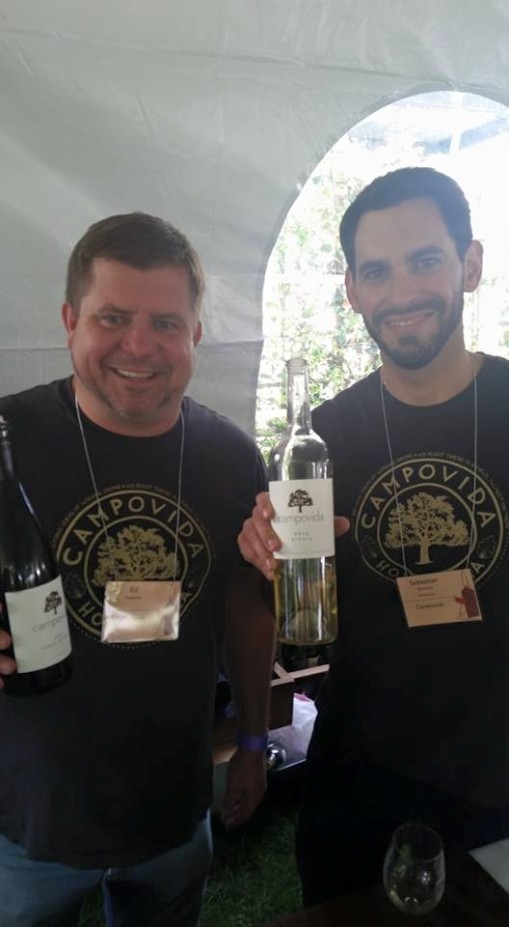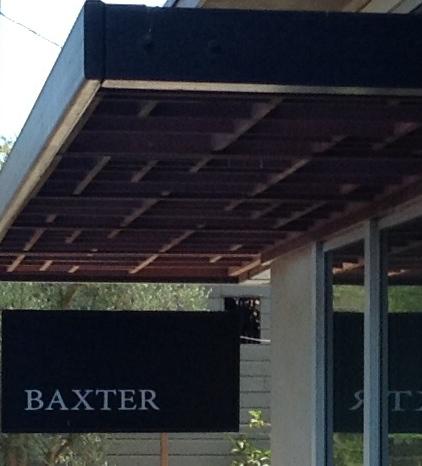John On Wine – Recap of a great three day wine weekend
Last week, I mentioned that I was attending some wine events and promised a recap of tastes of the eighteen gold medal winning wines made using Mendocino County grapes that were at the Barlow on Sunday in Sebastopol for the 2015 Press Democrat North Coast Wine Challenge grand tasting.
Upon arriving, I was instantly reminded of Prussian Field Marshall Helmuth von Moltke the Elder’s quote, “no plan of operations extends with any certainty beyond the first contact with the main hostile force,” which could be paraphrased and shortened, “no plan survives first contact.”
At check in, my badge could not be found, but I was saved by fellow writer and wine ambassador Thea Dwelle who recognized me and secured two wristbands for me and my tasting companion, Susan Johnson. Thank you Thea!
List in hand, ready to taste the wines in a planned order, I found that the wineries were not alphabetically ordered, but by wine type, whites and bubblies in one group, light reds and blush wines in another, and finally big reds in a last group. The problem, for me, is that a number of wineries won medals for more than one wine type, and the significant crowds made the tasting I had planned nearly impossible.
Instead, I decided to put my notebook away and simply taste what I wished, and enjoy myself. That new plan was a smashing success as there was much to enjoy.
I lived and worked in the Sonoma County wine industry for far longer than I have lived and worked here in Mendocino County, and saw many friends; the event was very much like a reunion for me. The wines were top notch, as you might expect from a collection of gold medal winners, and the food was beyond good, the food was great. Special thanks to all of the wine judges, including Christopher Sawyer who shared some of his event photos for this piece.

Two Michelin Star Cyrus’ chef Doug Keene with Foie Gras for Late Harvest and Caviar for Bubbly at The Barlow (photo by Christopher Sawyer)
I tasted Foie Gras and Caviar from Michelin two star awarded chef Doug Keene, spectacular pork treats from Food Network celebrity Duskie Estes and husband John Stewart, salmon, truffled mac and cheese, pork belly, tuna tataki, and so much more. Every bite was an absolute delight but some were so intensely flavorful that finding a wine that could pair well was a challenge – a challenge I accepted.
Wines, well that’s why I attended, right? I loved Carol Shelton’s new 2014 Wild Thing Chardonnay, Mendocino County, with oak but not so much as to mask the abundant and flavorful fruit notes. Navarro’s 2014 Pinot Blanc and Campovida’s 2013 Arneis were also drinking great. Handley’s 2014 Rose of Pinot Noir was bright and flavorful, a good match for many foods, and their Best of Mendocino County awarded 2012 Pinot Noir was especially delicious with gorgeous cherry berry fruit and depth, matched to oak and herb. Campovida’s 2013 Campo di Rossa, a Rhone blend, and Masut’s 2013 Pinot Noir rounded out my day’s favorite local red tastes. I finished my day with a taste of the 2013 Merriam Vineyards Chardonnay, Bacigalupi, Native Fermentation $56, poured by the multi-talented Toni DiLeo, and was well pleased with the choice. Toni and I sold a 1994 Bacigalupi Chardonnay made by Carol Shelton many years ago, and it brought the event full circle for me, with ribbon and a bow.

Campovida’s Sebastian Donoso with two Press Democrat North Coast Wine Challenge Gold Medal winners (photo by Christopher Sawyer)
__________
Before the Barlow event on Sunday, came 2015’s Anderson Valley Pinot Noir Festival. Once again, another amazing event put on by Mendocino County’s best organized appellation. I might be the largest cheerleader for inland Mendocino’s wine scene, but credit where credit is due, Janis MacDonald and her team at the Anderson Valley Winegrowers Association do the very best job reaching out to the press, marketing and promoting, and staging first class wine events within Mendocino County. Kudos go to Janis, Kristy Charles, and all of the amazing volunteers, for another memorable and worthwhile event.

Pizza is served by Stone & Embers at Balo Vineyard’s Welcome Dinner for the press (photo by John Cesano)
The event kicked off for me Thursday night with a Welcome Dinner at Balo Vineyards. There were more wines than I could taste, more winemakers and winery owners than I could chat with, but I said my hellos and tasted some delicious wines. Favorites of the night included the 2014 Avenging Angel Pinot Noir Blanc, a 2013 Philo Ridge Viognier with Greg Nelson’s grapes, the 2012 Waits-Mast Wentzel Vineyard Pinot Noir, the 2012 Donkey & Goat Broken Leg Vineyard Pinot Noir, 2012 Williams Selyem Ferrington Vineyard Pinot Noir, and a 1994 Husch Pinot Noir which I would describe as ‘faded glory’, a wine from a great vintage, a little beyond its prime, but filled with memories of other wines from that year. The appetizers, salads and pizza by Stone & Embers were excellent.
Friday morning’s Tech Conference featured a look at the state of Pinot Noir by Glenn McGourty, who shared that Pinot Noir acreage in the state has doubled, at least, since 2000, and that the variety is the most valuable grown per ton, on average. Nancy Smith and Jennifer Carah from The Nature Conservancy returned to update attendees on water flow and proposed efforts to balance the needs of fish and humans in the Navarro watershed. Andy Walker discussed rootstock and Jean-Jacques Lambert talked about soil in the two tech sessions aimed well over my head, but undoubtedly of value to the vineyards and winery owners attending. My favorite sessions included a panel tasting of Pinot Noir produced from different soil types, another panel tasting focusing on various Pinot Noir wines produced using Charles Vineyard grapes, and the lunch session with various Anderson Valley Pinot Noir wines and the best conference food ever served at a tech conference, prepared by Boont Berry Farm. I’m a simple taster, and my favorite sessions involve wine and a story. My favorite quote of the day came from Bill Hill of Expression 39 wine, on terroir (soil and climate), “there are a few places in the world that make wines that are really interesting, there are places in the world that make wines that shouldn’t.” The day’s conference amply demonstrated that Anderson Valley is a place to make Pinot Noir.
That night’s Casual BBQ at Lula Cellars catered by The Q was a blast. Lots of people gathered to enjoy the best event BBQ food served at one of these events, fantastic wine, great heartfelt country folk music, and the company of one another.
Saturday morning, at 8:50 am, I started working through tasting wines, taking comprehensive notes for each, at the Press Tasting at Scharffenberger Cellars. I took over 2 ½ hours to taste through about 55 wines, but it was a thoroughly enjoyable experience as John and Linda Compisi and Christopher Sawyer were also tasting and there were great conversations and cross talk over wines being tasted.
My favorite wines of the press tasting, in reverse alphabetical order, were the 2012 Waits-Mast Pinot Noir, Wentzel Vineyard, Anderson Valley; 2012 Witching Stick Cerise Vineyard Pinot Noir; 2011 Philo Ridge Vineyards Pinot Noir, Anderson Valley; 2013 Phillips Hill Anderson Valley Pinot Noir; 2013 Navarro Vineyards Pinot Noir, Deep End Blend, Anderson Valley; 2012 Husch Reserve Anderson Valley Pinot Noir; 2012 Handley Cellars Pinot Noir, Helluva Vineyard, Anderson Valley; 2012 Goldeneye Anderson Valley Pinot Noir; 2012 Fathers & Daughters Pinot Noir, Ella’s Reserve, Ferrington Vineyard (not a consensus choice, light, but stand out interesting); 2013 Drew Pinot Noir Fog-Eater Anderson Valley; 2013 Bink Anderson Valley Pinot Noir; and 2012 Baxter Pinot Noir Anderson Valley (tasted at the Grand Tasting).
The Grand Tasting at Goldeneye Winery was indeed grand, with smiling winemakers pouring for smiling attendees. The smiles were easy to come by, bought with some of the best wine and food imaginable, from among many of the county’s best producers.
Tom Liden, Mendocino County photographer extraordinaire, was on hand and his photos are as gorgeous as the wine and food served. Thanks for sharing, Tom.
__________
Next week, I’ll be recapping the Chef’s Wine Dinner at Crush Italian Steakhouse in Ukiah, featuring the wines of Graziano Family of Wines.
__________
NOTE: This piece is scheduled to run in the Ukiah Daily Journal newspaper on Thursday, May 28, 2015 and, instead of waiting for publication there before archiving here, I am running it here first for timeliness. The early reference to last week’s column will actually be a column that runs tomorrow, and be archived out of order shortly after, here.







































